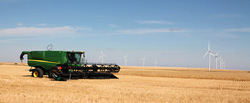
| and Bigford Cemetery Saskatchewan, Canada James S. and Susan E.W. Aber |
| Introduction | Centennial wind farm |
| Bigford Cemetery | References |

| and Bigford Cemetery Saskatchewan, Canada James S. and Susan E.W. Aber |
| Introduction | Centennial wind farm |
| Bigford Cemetery | References |
For this trip, wind energy was a primary theme. However, weather conditions for KAP were generally unfavorable—cloudy, rainy, and hazy smoke from wildfires in the western US and Canada. In fact, we had only one really good day for KAP at a pioneer cemetery located next to a wind farm near Swift Current. This town is home to the SaskPower Windscape Kite Festival in June.
Our KAP day began with mostly sunny, smoke-free sky, and we were able to fly the kite with a moderate breeze from the northwest in the early afternoon. We utilized our large rokkaku kite, as usual, along with the autoKAP Sony camera rig. Soon after we completed the flight, clouds moved in and put an end to any further KAP.
The Centennial Wind Power Facility is located on the Missouri Coteau about 26 km (~16 miles) southeast of Swift Current. Elevation of the wind farm vicinity is approximately 880 m (~2900 feet), some 140 m (~460 feet) above Swift Current. The Centennial wind farm was built in 2005 and commissioned in 2006. The name comes from Saskatchewan's centennial in 2005. At the time it was commissioned, it was the largest wind-energy facility in Canada. The wind farm is owned and operated by SaskPower the main electric utility for the province.
Centennial wind farm
Canada ranks ninth in the world for wind-power capacity, and Saskatchewan plays a prominent role (TWP Canada 2024). The province hosts 11 wind farms for which the total generating capacity is approximately 620 megawatts (MW). In general terms, the southern one-third of Saskatchewan is an open, wind-swept, prairie (Padbury and Acton 1994). This largely rural landscape is well suited for development of wind energy. Many wind farms are situated on the Missouri Coteau, which is a hilly, glaciated, upland that marks the continental drainage divide between the Missouri-Mississippi basin to the south and the Saskatchewan-Hudson basin to the north.

| All turbines are connected via underground cables to a central substation seen here. Electricity is sent on overhead 34.5 kV (kilovolt) transmission lines to the provincial grid system. |
Given the cold winters of Saskatchewan, turbines are capable of running at temperatures down to -30 °C (-22 °F), but shut off at lower temperatures. The wind farm has 83 turbines, each with a 1.8 MW capacity and a combined capacity of nearly 150 MW, which is enough to power about 65,000 homes. These sizes and capacities are typical for turbines and wind farms built in the first decade of this century.

| Wheat harvest underway beside and within the Centennial Wind Power Facility. |
Some family plots have been improved and are well cared for. Aside from mowing, much of the cemetery has suffered from a general lack of maintenance. This is evidenced by collapsed graves, numerous animal burrows, and growth of bushes and small trees over graves. According to Find a Grave, 50 individuals are listed in the cemetery as documented by tombstones. Most of these burials took place between 1920 and 1960.
In addition to the 50 recorded individuals, many more unmarked graves are certainly present. Unmarked burials are indicated by mounds or depressions. In many early cemeteries, graves were identified initially with wooden markers. The intentions were to place stone markers later, but the families either died out or moved away before permanent markers were installed. Such wooden markers may have been destroyed by wildfire or rot and are now long gone.
As a result of these factors, the cemetery presents a haphazard and almost random appearance from the ground viewpoint. However, the aerial vantage revealed a well-organized layout for lanes and square blocks arranged on a compass grid. All burials are aligned east-west. This regular pattern is evident throughout the cemetery, but is especially prominent in the central portion where most of the graves are situated. The pattern appears because of narrow furrows or subtle ridges that support distinctive vegetation. Stripes and circles of grass mowing are overprinted on the cemetery layout.